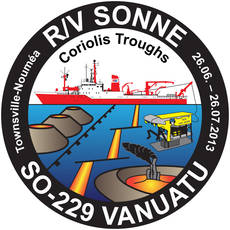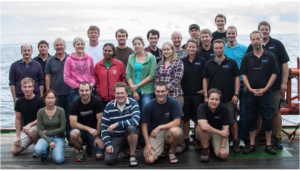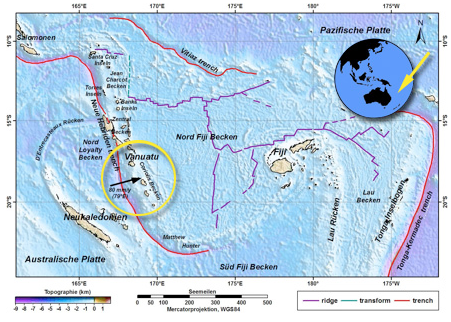Expedition SO-229 VANUATU (26.06.-26.07.2013)
 Expedition SO-229 VANUATU (26.06.-26.07.2013)
Expedition SO-229 VANUATU (26.06.-26.07.2013)
Follow our expedition: facebook.com/groups/SO229
Or see the Log-Book

Key data
-
- approx. 1.1 million € funding, provided by the German Federal Ministry of Education and Research (BMBF)
- 32 days at sea with the German research vessel SONNE from Townsville (AUS) to the working area east of Vanuatu (Coriolis Troughs) and back to Nouméa (F)
- Equipment deployed: deep-sea robot Kiel 6000, TV grab, volcanite shock tube, CTD, MAPR.
- Cooperations: Federal Institute for Geosciences and Natural Resources (BGR, Dr. U. Schwarz-Schampera), Jacobs University Bremen (Prof. Dr. A. Koschinsky), Christian Albrechts University Kiel (Dr. C.-D. Garbe-Schönberg), University of Ottawa (Prof. Dr. M. Hannington), Nautilus Minerals (Australia).
- Read more …

Participiants from Erlangen
Dr. Philipp A. Brandl
Fabian Kemner
Michael Greß
Publications SO229
- Anderson, M.O., Hannington, M.D., Haase, K.M., Schwarz-Schampera, U., Augustin, N., and McConachy, T.F., 2016. Tectonic focusing of voluminous basaltic eruptions in magma-deficient backarc rifts. Earth and Planetary Science Letters 440, 43-55.
- Lima, S.M., Haase, K.M., Beier, C., Regelous, M., Brandl, P.A., Hauff, F., Krumm, S., 2017. Magmatic evolution and source variations at the Nifonea Ridge (New Hebrides Island Arc). Journal of Petrology 58, 473-494. doi: 1093/petrology/egx023.
- Schmidt, K., Garbe-Schönberg, D., Hannington, M.D., Anderson, M.O., Bühring, B., Haase, K., Haruel, C., Lupton, J.E., Koschinsky, A., 2017. Boiling vapour-type fluids from the Nifonea vent field (New Hebrides Back-Arc, Vanuatu, SW Pacific): Geochemistry of an early-stage, post-eruptive hydrothermal system. Geochimica et Cosmochimica Acta 207, 185-209. Doi: 10.1016/j.gca.2017.03.016.1016/j.gca.2017.03.016
- Beier, C., Brandl, P.A., Lima, S.M., and Haase, K.M., 2018. Tectonic control on the genesis of magmas in the New Hebrides arc (Vanuatu). Lithos 312-313, 290-307. Doi: 1016/j.lithos.2018.05.011.
- Nasemann, P., Gault-Ringold, M., Stirling, C.H., Koschinsky, A., and Sander, S.G., 2018. Processes affecting the isotopic composition of dissolved iron in hydrothermal plumes: A case study from the Vanuatu back-arc. Chemical Geology 476, 70-84. Doi: 10.1016/h.chemgeo.2017.11.005.
- Wilckens, F.K., Reeves, E.P., Bach, W., Meixner, A., Seewald, J.S., Koschinsky, A., Kasemann, S.A., 2018. The influence of magmatic fluids and phase separation on B systematics in submarine hydrothermal vent fluids from back-arc basins.Geochimica et Cosmochimica Acta, 232, 140 -162, doi: 10.1016/j.gca.2018.04.023.
- Haase, K.M., Gress, M.U., Lima, S.M., Regelous, M.,Beier, C., Romer, R.L., and Bellon, H., 2020. Evolution of magmatism in the New Hebrides Island Arc and in initial back-arc rifting, SW Pacific. Geochemistry, Geophysics, Geosystems 21, e2020GC008946, doi: 10.1029/2020GC008946.
- Keith, M., Haase, K.M., Häckel, F., Schwarz-Schampera, U., Klemd, R., Hannington, M., Strauss, H., McConachy, T., and Anderson, M., 2021. Trace element fractionation and precipitation in submarine back-arc hydrothermal systems, Nifonea caldera, New Hebrides subduction zone. Ore Geology Reviews 135, 104211, doi: 10.1016/j.oregeorev.2021.104211.
The research project “COVOLVE
Project Summary
The southern New Hebrides island arc has been rifted for about 3 Ma, resulting in three volcanic and hydrothermally active rift basins in the Coriolis Basin. Globally unique is the occurrence of alkaline island arc magmas with enrichments in Nb and Ta compared to the highly depleted island arc magmas at other localities, and the occurrence of different magma sources whose distribution and formation is unclear. The importance and origin of alkaline magmas for metallogenetic processes in young island arcs is still unclear. An example is found so far only in the Tabar-Lihir-Tanga-Feni island arc in Papua New Guinea, where fractionation of highly volatile elements and one of the richest gold deposits occurs. Detailed stratigraphic sampling of active volcanoes in the southern island arc and backarc therefore provide unique opportunities to determine magma sources and mantle flow over the past 6 Ma. Three occurrences of hydrothermal vents or precipitates have been described in the New Hebrides island arc so far, but have not been studied in detail. This project will use the ROV (Remotely Operated Vehicle) Kiel 6000 to investigate and sample the hydrothermal vents to determine the composition of the fluids, precipitates, and faunas. The magmas of the island arc contain a lot of sulfur and have an unusual composition, which probably also affects the hydrothermal processes.
The ROV will be used to investigate the temporal and chemical variability between magma genesis, volcanism, and hydrothermalism at submarine calderas in the Coriolis Basin. Of importance are questions of lithologic control by volatile-rich alkaline magmas and influences of volcanic evolution on metallogenetic processes, as well as fluid dynamics and evolution. The effect of different water depths on degassing processes and composition of hydrothermal fluids is the main focus. Another focus is the investigation of the variability of magmatic differentiation (trachybasaltic- trachyandesitic-dacitic) along short island arc sections and feedback on metal fractionation and hydrothermal activity.
